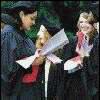 |
|
World Scholars Shatter Myths About the African Slave Trade at York U. Conference on the Central Role of Brazil
The conference, Enslaving Connections: Africa and Brazil During the Era of the Slave Trade, is sponsored by the Department of History and the Nigerian Hinterland Project at York University, with funding from: the Social Sciences and Humanities Research Council; the Funda┴ôo Calouste Gulbenkian (Servi┴o da Coopera┴ôo para o Desenvolvimento); the Instituto Cam×es; Funda┴ôo para a Ci═ncia e Tecnologia (Programa Lusitĺnia); the Minist╚rio das Rela┴×es Exteriores (Departamento da Cultura) of Brasil; and the York University Department of History. Additional support has been provided by the Nigerian Hinterland Project, Vice-President Academic, Faculty of Arts, Founders College, York International, African Studies Program, all at York University, and the Consulado Geral de Portugal in Toronto.
"This is an unprecedented opportunity to bring together the research that is scattered around the globe, and the historians engaged in recovering and piecing together the evidence of this important era in world history," says Jose Curto, History professor at York University and principal organizer of the conference.
"There is a misconception about the role of the 13 colonies of the United States in the Atlantic slave trade," says Curto. "And the slaves brought to the Americas were not as culturally isolated as we once thought, which says something about how African cultures survived in the new world." Curto says that the areas of Africa that supplied slaves were concentrated, as were the areas that received them, allowing for communities to congregate, and contradicting the notion that a slave, by definition, assimilated into the culture of the master.
It is now generally recognized that of the estimated 12 million African slaves shipped to the Americas from the years 1450 to 1900, 2 million died in transit. Of the remaining 10 million, about 4 million went to Brazil, another 4.5 million were scattered around the Caribbean, and approximately 1.5 million went to the southern United States and the Spanish mainland countries such as Argentina, Mexico and Peru.
"The survival rate of slaves put to work in the cane fields of the tropics was so low that countries like Brazil were continuously importing slaves to replace those who had died," says Curto, adding that African slave populations in the tropics could not reproduce themselves. "In contrast, by 1860, the total slave population imported to the southern United States had reproduced itself from half a million to 4 million."
The conference at York will bring together scholars from Africa, Europe, North, Central and South America to share the extensive research materials located in Brazil, Angola and Portugal, as well as less accessible documentation in other countries bordering the Atlantic. It will expose Anglophone scholars to the research that has been done in Portuguese, and will enable scholars of the African impact on Brazil to finally interact with those working on the Brazilian impact on Africa, where Brazilians involved in the slave trade often settled and established communities.
"Despite efforts by Brazil to Űwhiten' its population and destroy all transaction records after it abolished slavery in 1888, Brazilians can still shed a great deal of light on what was going on in Africa at the time of the Atlantic slave trade," says Curto. He says historians are beginning to piece together a variety of community links through Brazilian Catholic church records of baptisms, marriages and burials and through notarial records and post mortem inventories of assets.
Among the presenters at the conference: Robin Law of the University of Stirling in Scotland, one of the world's foremost authorities on the pre-colonial history of West Africa, who will discuss his work in tracking the career of the Brazilian-born slave trader Francisco Felix de Souza, the founding father of the de Souzas in Africa, who amassed great wealth and influence as a resident of the West African coastal community of Ouidah; Manolo G. Florentino of the Universidade Federal do Rio de Janeiro, one of the leading historians on Africans in Brazil, who will discuss his work on ethnicity and slavery amongst the Bantu of Rio de Janeiro; and Rosa da Cruz e Silva, director of the Arquivo Hist█rico Nacional in Luanda, a rising Angolan historian who will discuss her work on the Brazilian impact upon conflicts between African states and the Portuguese colonial state.
Keynote speaker, Alberto da Costa e Silva, will summarize current knowledge about Brazil-Africa connections during the slave trade and recommend a direction for future research by a new generation of scholars working in an increasingly digitalized world. A diplomat by training and a historian, his seminal work A Enxada e a Lan┴a (The Hoe and the Spear), Rio de Janeiro: Nova Fronteira, 1996, 2nd edition, is the first full-length study of Africa before the arrival of the Portuguese in the Portuguese language. Da Costa e Silva, was Brazil's ambassador to Nigeria and B╚nin from 1979 to 1983 and has just been elected to the prestigious Brazilian Academy.
For details on the conference program, check the website at: www.yorku.ca/research/nhp/enslapro.html.
For further information, please contact:
Jose Curto
Susan Bigelow
|
|
|
| | Welcome to York University | Latest Release | Release Archives | |
![[to York's Home Page]](../../images/yorklogos.gif)
